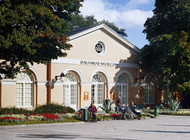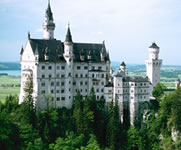Other highlights
Museums

The Duchess Anna Amalia library, a veritable treasure trove of the written word, forms part of the "Weimar Classicism" cultural ensemble. It has proved a popular destination for literary scholars, students and book-lovers for almost 250 years. The collection is widely regarded for its historical volumes, and offers numerous reading areas, workplaces for the visually impaired and blind, exhibition spaces and a room suitable for group work. Closed on Sundays.
» Further information
Built in 1709, the baroque house where Goethe lived is now a historical monument to his memory. Within its walls, he composed some of the greatest poetic works in the literary canon. Visitors can see his garden, living quarters and reception room with its collection of historical keepsakes, as well as the room occupied by his wife Christiane, his study and the library. The museum offers guided tours, discussions, lectures and seminars. Specialist tours can be arranged on request. Closed on Mondays.
» Further information
Bauhaus, the renowned art and architecture college founded in Weimar, was the 20th century's most influential school of design. Established in 1995, the Bauhaus Museum tells the story of art and the Bauhaus institute from 1900-1930. Its permanent exhibition consists of around 500 exhibits, covering graphic and free art; the history of the Grand Ducal School of Fine Arts from 1907-1915 under art nouveau pioneer Henry van de Velde; the Bauhaus in Weimar from 1919-1925; and the School of Craft, Design and Architecture from 1926-1930. Also on display are ground-breaking works by Walter Gropius (the school's first director), Johannes Itten, Lyonel Feininger and Marcel Breuer, as well as various pieces from the Bauhaus workshops. Open daily.
» www.weimar.de
Weimar's "New Museum" is housed in the stunning neo-Renaissance building that was once home to the Grand-Ducal Museum. It was established in 1999 to kick-start Weimar's year as the European City of Culture. And was the first museum of contemporary art to open in eastern Germany after reunification. The gallery is centred around the Paul Maenz collection. This features works by the international avant garde from the 1960s onward, including minimal and conceptual art from the US as well as pieces originating from movements in Germany and Italy. The museum also hosts temporary exhibitions on 20th century art. Closed on Mondays. Guided tours on request.
» www.weimar.de
Buchenwald concentration camp on Ettersberg hill near Weimar, which operated as a labour camp between 1937 and 1945, was one of the largest in Germany. A total of 250,000 people from all over Europe were imprisoned at the camp during this period, over 50,000 of whom did not survive. After the camp was liberated in 1945, the site continued to be used as an internment camp by the occupying Soviet forces. Visitors can see the site of the former camp including the gate building, the detention cells, the crematorium, the depot, the disinfection station, the former railway station, the remains of the SS zoo and the SS officers' quarters, the quarry, the cemetery for those who died in the Soviet special camp and the memorial. Closed on Mondays. Audio guide in several languages. Guided tours on request.
» www.buchenwald.de
This two-wing baroque building was erected between 1767 and 1769 as a state palace. Duchess Anna Amalia lived there from 1775 – shortly after her son Carl August took control of Weimar – until her death in 1807. Today, the residence serves as a powerful reminder of aristocratic life in the town. The Tafelzimmer for example, was popular among the luminaries of Classical Weimar, who met and exchanged ideas there. Goethe's "Friday Society", which he founded in 1791, also held sessions within its walls. First opened as a museum in 1875, Wittums Palace gives visitors the chance to see living quarters and state rooms from the 18th century. The historic ensemble also encompasses a classical banqueting hall, late baroque paintings by Adam Friedrich Oesers, antique furniture, objets d'art and the "round table room". Closed on Mondays.
» www.weimar.de
Built in 1777 Schiller's House is the oldest building and the only one of its type in Schillerstrasse, Weimar. Friedrich Schiller (1759-1805) bought it in 1802 as a residence for himself and his family. By moving there he was near to his friend and collaborator Goethe and close to the theatre where his successful plays were feted. He reached the height of his popularity with "Wallenstein", "Maria Stuart", "The Maid of Orleans" and "William Tell". Visitors can tour the whole house, including the kitchen, servants' room, living quarters, parlour, Charlotte's room, the small reception room and the parlour-cum-study in which he died in 1805. Closed on Tuesdays.
» www.klassik-stiftung.de
Travel Planner
Select an option...
Map of Germany
Hotels in Weimar
Loading



